Labyrinth (1986): Power, Sex, and Coming of Age
Many childhood favorites fall apart when re-visited twenty or thirty years later, but Labyrinth has aged well with its audience and holds its emotional resonance despite a more cynical, more familiar eye. Who in 1986 could have predicted David Bowie’s lip gloss would have such staying power? Yet Labyrinth remains a fan favorite nearly three decades later, loved partly for how closely it adheres to classic fairy tale structure… but mostly because of how it breaks those same rules.
The fairy tale aspects of the film are both obvious and subtle. At its heart the “fairy tale” is a code of instructions for passing into adulthood, and as such, the symbolism in fairy tales speaks to the most primal and difficult facets of growing up: sex or death, or both.
The stories written by Charles Perrault and collected by The Brothers Grimm are certainly darker than their Disney counterparts – in the earlier version, Snow White’s stepmother danced to death in red-hot shoes — but it is also true that even stripped down, a strong tale matures with its audience, becoming more full of meaning as a reader or viewer ages. Red Riding Hood’s famous cloak symbolizes a young woman’s first menses, and it evokes the murder in her tale as well. Symbols, humor, and metaphor a child will miss, or misunderstand, become outright lewd to the eyes of an older and more experienced adult. This fact horrifies many and delights the rest of us.
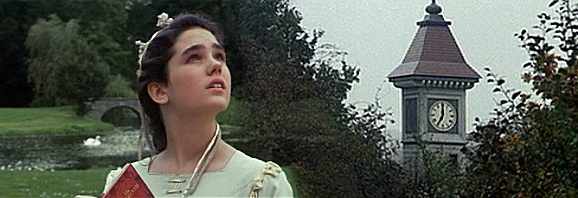
Like the story of Red Riding Hood, Labyrinth features a young woman entering a wild place, a place where sex and death cohabit in shameless abandon. In Sarah’s labyrinth death does not loom as explicitly as it does in Red’s forest, but both young women waltz innocently into the twilight of their childhood on the arms of monsters. Unlike classic fairy tales, Labyrinth is deliberately constructed to cross from the once-upon-a-time world into the “real” one. The movie’s opening shot is of Sarah speaking stilted language while wearing an ambiguously Old Timey gown, but then we soon see she’s rehearsing for a play and can’t remember her lines. This telegraphs the story’s willingness to subvert expectations. It also heightens the audience’s connection to Sarah simply because she more closely reflects them; she’s a “normal” girl.
Sarah is soon taken from “normal” and plunged into fantasies both delightful and dark; her labyrinthine journey is layered and contradictory. Jareth, Goblin King Extraordinaire, is tempting Suitor, stern Father Figure, and malicious Villain, all in one. He also has a measure of wicked, petulant Playmate thrown into the mix, though that is a face usually worn by younger, less powerful characters like Puck from Midsummer Night’s Dream. In all his roles, however, Jareth is much closer to Oberon than Puck — he is, shall we say, well-endowed with all the props befitting a larger-than-life leading man. In other words: the wardrobe crew stuffed his pants.
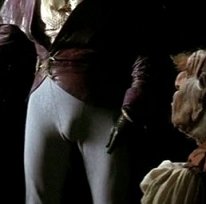
- My, what big hands you have, grandma.
The internet hosts many jokes about Jareth’s pants, and I’m clearly not above adding a few, but the wardrobe decision speaks directly to the nature of the character and the story being told. Fairy tales feature archetypes. It is not enough that Jareth, King Tightpants, is David Friggin’ Bowie. He must be David Friggin’ Bowie turned up to an eleven. He must be a mature King, with the full bevy of fertility symbols on display, including that beautiful cane he uses to threaten and poke people, the BDSM-inspired clothing choices, and the fawning women in the masquerade ball.
It isn’t just Jareth, Bearer of Magic Balls, who displays phallic symbols. Sarah’s journey from childhood to young adult is fraught with reminders at every turn: she is changing. All that she has loved is fading, and it feels like dying, like she will die if she loses it all… and so she fights to hold on to what she knows. But during her struggle she is reminded constantly of the other world looming just beyond the barrier; neither she nor the viewer are allowed to forget that she is being stalked by time.
As an example of those “adult situations” on Sarah’s horizon, let’s look at Hoggle. Hoggle eventually becomes one of Sarah’s trusted advisors, but the first time we and Sarah meet him, he has his trousers open and is peeing into a pond.
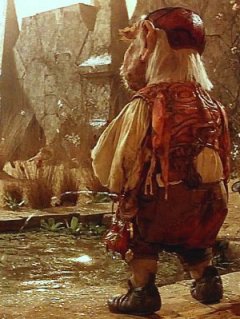
To the young viewer, and all viewers with an Inner Seven Year Old, this is merely a joke about urination and is varying degrees of hilarious on that basis alone. The older viewer will instead contemplate the sexual undertones inherent in introducing a character with bare penis in hand, even though Hoggle himself is never a potential Suitor. Even so, when Jareth punishes Hoggle by sending him to the Pit of Eternal Stench it’s specifically for the sin of Sarah giving him a kiss.
Jareth: If she kisses you, I’ll turn you into a Prince.
Hoggle: <hopeful> Really?
Jareth: <with malicious glee> The Prince of Eternal Stench!
It seems Jareth is not above petty jealousy.
The symbolism in Labyrinth isn’t limited to the sexual. As an example: an older, more educated viewer finds an Easter egg in Hoggle’s introduction. If you aren’t too distracted by the, well, stream, you might notice Hoggle’s jacket has a face on the back – he’s two-faced; it’s right there. It’s the second-most obvious thing Sarah sees, but she doesn’t understand what it means. In addition to being a slang term for betrayal, a sin of which Hoggle is certainly guilty, the double face also invokes the two-faced Roman god of thresholds, Janus. And Hoggle is indeed the gatekeeper who shows Sarah the door to the labyrinth and how to open it. This is one example of the layered symbolism that allows Labyrinth to hold up so well to adult eyes.
Here’s another: The Babe With the Power.
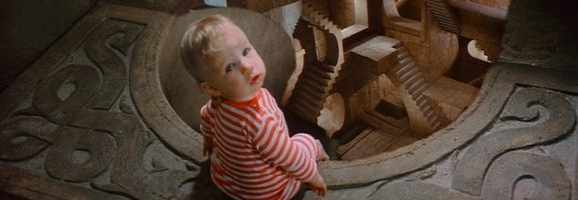
Sarah’s baby brother Toby, aka The Babe With the Power, aka Plot McGuffin Du Bowie, is an interesting collection of symbols himself.
Life is full of things you can’t know until you’ve experienced them; some “first times” are given more significance than others. Certainly most acts involving sex or death are important thresholds, and whether the crossing of those lines is exhilarating, traumatic, or anti-climactic (sometimes literally), there is almost always a sense of a boundary being crossed. In this sense, innocence is more synonymous with ignorance than with purity.
In the pure symbolism of the fairy tale, sex and innocence exist in opposition, which is not so much a matter of judgment or slut-shaming as it is a function of knowledge gained vs. knowledge still to be learned. Toby sits on the cusp of this divide, steam of pure creation still rising heavy off him while his wide eyes view the world with wonder and trust. He is entering the childhood Sarah is leaving, which on some level she understands and resents… but he also represents, via motherhood, the exotic world of adulthood and adult pleasures which calls to her. His red and white onesie displays his ties to both sides of this divide: blood (and all that means) on the one hand, a blank slate on the other.
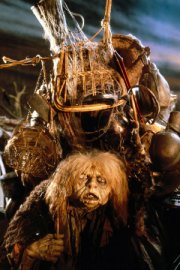
The Babe would have become a goblin if Sarah had failed, and one presumes that’s how Jareth’s goblin servants came to be. This means that he’s been stealing little brothers (and sisters, one supposes) out of cribs for a very long time, and further it seems that they themselves are the not the goal. What, then, would have become of Sarah had she agreed to stay? Would she have truly become Queen, as Jareth implied? There seem to be a lot of goblins – how many other elder siblings have taken Jareth’s offer, and what happened to them? Perhaps instead of becoming Queen, Sarah might have become one of the labyrinth’s deformed inhabitants, endlessly serving Jareth’s will.
Sarah’s trepidation regarding Jareth comes first from the fact that he seems to be responsible for keeping her from Toby, (although that, like so much else, was her own decision) and second from her well-earned distrust of his promises. But the myriad of conflicting archetypes he represents causes an even deeper level of unease. The roles of Playmate, Suitor, King, and Father are inherently in conflict, yet no matter which role he assumes, Sarah is too liminally balanced to fully accept him. She wants all and none of those, all at once, which eventually leads to Jareth’s statement that he is exhausted from living up to her expectations.
Consider her experience in the masquerade ball. This is what adulthood looks like to 15-year-old Sarah: painted masks, lascivious grins, a confusing cacophony of debauch and threat, and she the only one in a pure-white dress. The masquerade’s mixed messages are a function of Sarah’s conflict with Jareth – she desires to be privy to adult entertainments, yet they seem crass and false and dangerous. Too much, too soon, and it drives her to seek retreat.
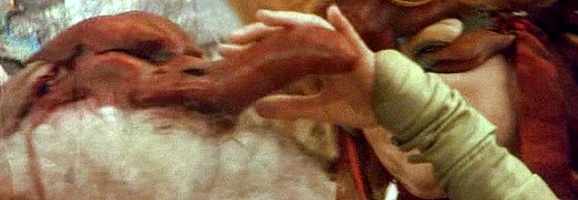
Yet despite sexual and phallic symbols lurking throughout the film, and despite its adherence to fairy tale structure, Labyrinth breaks the rules at the climax, and it is awesome.
Vladimir Propp, in his work The Morphology of the Folktale, devised a system to categorize the plot structure of fairy tales as a way of classifying and comparing stories. A story can be said to qualify as a fairy tale based on how closely it follows Proppian functions. For example, the first function in Proppian analysis is I: One of the members of a family absents himself from home. In Labyrinth, we first meet Sarah in the park, where she has gone to escape her unhappiness at home. The second function in Proppian analysis happens when the hero is given an interdiction or command; Sarah is told to watch the baby.
For the majority of the movie, Labyrinth follows the Proppian functions almost exactly, making it a fairy tale by definition. There are, however, a few distinct and consistent differences which culminate in a major divergence in the resolution. One small but telling deviation happens when Sarah and Jareth first meet. In Proppian terms, that’s function XVI: The hero and villain engage in direct combat. The next step should be XVII: The hero is branded. The “brand” can be almost anything, from a wound to a ring, but Sarah doesn’t take anything that Jareth offers, nor does he wound or mark her in any way.
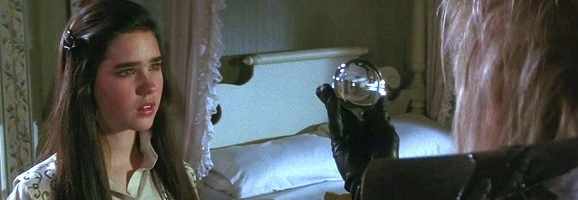
Thus Sarah remains un-branded – neither penetrated by a weapon nor claimed by jewelry – and this sets up a resolution that is far more feminist than fairy tale. While her hero’s journey seems full of blind corners and unfair hardships, it is nonetheless entirely dictated by her own choices. Even giving up Toby in the first place was a decision Sarah made, and with which Jareth complied.
Nearing the final confrontation, Jareth sings, “Everything I’ve done, I’ve done for you.” And this is the heart of the tale: it was always Sarah’s story, never Jareth’s. The power was hers for the claiming, as soon as she had enough maturity to grasp it. Jareth’s mis-matched roles, like his mis-matched eyes, were a function of Sarah not knowing or understanding what she wanted or where she belonged. He attempted to rule her – to woo her – by living up to her inexpert expectations of masculinity.
A classic, true-to-form fairy tale resolves with either an ascension to the throne or a wedding. In Proppian analysis, this is function XXXI: The hero is married and/or ascends the throne. Ostensibly, Sarah is given the choice to do both, assuming it’s true she would have been Jareth’s Queen had she stayed. Jareth offers Sarah her dreams, insofar as she is capable of imagining them, but they would always be dreams composed of his power, not built by hers. This is the standard fairy tale: Cinderella doesn’t conquer territory of her own, she marries up.
Faced with Jareth’s offer to be her slave if only she will fear him, love him, and do as he says, Sarah breaks the fairy tale mold by refusing her Suitor and the ascension. She thus comes into her own power, rather than the borrowed reflection of the power wielded by the Suitor. In their final confrontation, Sarah begins reciting the lines from the play she was rehearsing at the film’s beginning, but Jareth doesn’t physically step back until she gets to the phrase, “For my will is as strong as yours.” Before she can add, “and my kingdom as great” he interrupts to derail her by offering her another magic ball of glittery dream-stuff… which she again refuses.
Sarah verbally stumbles before she can conclude with the line she had such difficulty remembering at the beginning of her tale, but then it comes to her. “You have no power over me,” she says in triumphant epiphany, and with that she and Toby return to their world.
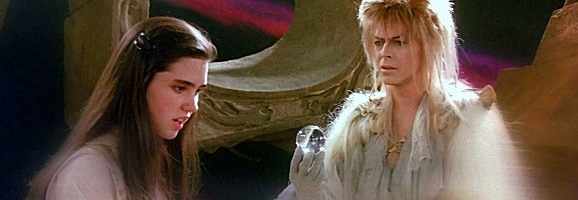
Thus our fairy tale princess returns victoriously home with neither wedding ring, nor wedding night, nor crown, nor King. Materially Sarah’s success is limited to a return of the status quo; the effects of her childish tantrum have been erased and Toby is back in his crib. Yet she has achieved, for the first time, some measure of understanding about the nature of her own power and the responsibilities inherent in adulthood. She knows that she is not yet ready for the full experience, and she accepts that. Just as when she made a choice to lose Toby, she has made a choice to take him back. She claims her sexuality as her own, and her innocence in this regard is not a win for the sake of purity, but a choice she makes with as much understanding as possible.
Labyrinth’s ending then gives us one additional surprise. Hoggle, and the other advisors and companions Sarah has made during her journey and struggle, do not stay confined to the fairy tale world of the labyrinth; they return with her. Once bound to Jareth, they are now Sarah’s – not servants, but friends – and their various qualities (honor, loyalty) are hers to call upon. They are, quite markedly, not included in the collection of childish things Sarah must part with in order to be a mature woman; they are part of the kingdom and power she has claimed.
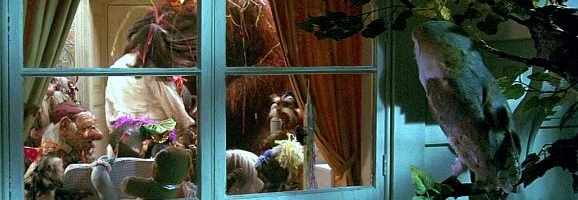
And in the last scene of the movie, Jareth (in owl form) sits outside Sarah’s window. He has not been banished, but must wait to be invited in again on Sarah’s terms.
What do you think? Leave a comment.











I think it has great potential as a stage musical!
Find The.Luciferian.Doctrine.pdf
showed it to my 6yo son the other day. at first he could tell it was an older movie while she’s in the park acting like a drama nerd….my son yells “boorrring!” haha….
then a few minutes later the second the goblins are all on screen staring at the camera he was hooked and watched the whole movie, and has since watched it 2-3 more times.
movie definitely holds up, although i had to laugh out loud a bit when jareth’s crystal ball turns into a snake and he quickly looks at her and says “don’t defy me!” and throws the snake onto her lol how freaking corny were the 80’s?
good stuff, wayyyyy too much cgi in movies these days. jim henson was a pioneer
Definitely. I recognize that the film has its flaws, but in my mind, it’ll always be a classic…
They should make a sequel called
Labyrinth I I : the revenge of the bulge
The first half – when Jen Connelly is in the actual titular Labyrinth – is great.
A lot of strange stuff happen, we see different creatures, traps, riddles, puzzles, and the overall feeling is great.
However, the things start to fall apart when Connelly and Ludo get into the woods/swamp:
Jen gets attacked by the Fire Gang, a scene that is weird, but not in a good way.
They meet Sir Dydimus, a very annoying character, all the while Ludo annoys us with his constant: ”It stiiiiiiiiinks!” over and over again.
Then we have Connelly’s dream where she is dancing at the ball.
Then the scene at the junkyard.
And then, the tiresome battle against the Goblins in the Goblin City, which is resolved by Deus ex machina.
And then, that trippy final showdown with the Goblin King.
Now, the first half (Labyrinth) and the second half are very much different.
I didn’t like the change from the mysterious and puzzling first half, to the trippy and tiresome second half.
I do agree for the most part, the actual Labyrinth stuff in the first half is really great, the rest while not awful feels a bit uneven and not really what I want from a labyrinth adventure.
Some of the things you say are not understandable. What does ‘titular’ and ‘Deus ex machina’ mean? Coherent thought is not really a part of your questioning. And although I do understand you are trying to point out that in your opinion the flow of the movie seemed to be divided, I’ve never thought it was choppy. Then again, I am not sure if you got the point of the movie or watched it very closely.
I’m not sure why you don’t understand the aforementioned poster’s thoughts. “Titular” in that the TITLE, Labyrinth, is named for said Labyrinth. “Deus Ex Machina” is a well-known concept in literary and film analysis. She defeats him by reciting a series of words that have no support within the rules of he story, no argument for why this should be an effective means of victory.
The film is absolutely divided. I do not believe this is an accident; it seems like a distinct first and second act. Whether or not you feel that the acts are equally engaging is subjective, but the division is present, and likely intentional.
I always preferred the first act myself. I think that reflects my own yearning for the world of fantasy and childhood, of possibility over answering the demands of ascending into adulthood and facing what is fear-inducing and sullied.
Also, I really enjoyed this analysis of the film and the responses to it.
It’s not deus ex machina: the words do have power within the context of the film. Sarah gives away her power (that is, she empowers Jareth) in the beginning, and like the “Big Bang”, the Labyrinth universe comes into being. The struggles that she must face are her unintended creation because she wants something to be (her crying brother, her adolescent life in general!) other than the way it actually is (like an undertone created by differing musical tones). Suffice it to say, she defeats the Goblin King when like the Buddha’s enlightenment, she realizes that the object of her senses has no power over her, and the world falls down because it lost its only means of support: Sarah’s power.
You see, it was her single moment of selfish petulance that bore the whole thing: the Labyrinth, Jareth, the characters… all of it. And like an addiction that we create with a single action (like smoking that first cigarette), we foster the very thing that overpowers us. And so it is that our out-of-hand creations are born from and empowered by our own acted-upon desires. They say to us, ‘Let me rule you and I’ll be your slave.’
It only takes one mistake to create a whole world of suffering and confusion.
SPOT ON ANALYSIS. Bravo. (And just… le sigh to those who think the second half of the movie doesn’t make sense or doesn’t blend…. they just. don’t. get it.)
(ETA: My “spot-on analysis” comment was in response to James’ comment. Really well-said. ☺️)
I don’t know how old you are or how old you were when you first saw Labyrinth, but I saw it as a child back when it came out and even though it is very noticeably different after the midway point, as you mentioned – I personally loved many aspects of the 2nd half.
Sir Dydimus was my favorite part of the film. The Fire Gang was frightening, effective, a very memorable scene – in a good way (IMO). The junkyard scene was amazing & highlighted how we already saw most of the film’s creatures in her own bedroom in the opening scene.
The ballroom scene, that I will give you – as an adult, I love the song in that segment, but as a child I thought the whole thing was a bore.
But otherwise, as a child, seeing the film in its own time & at the appropriate age for this type of film, I thought it was 99% a home run – fun, imaginative, rewatchable, interesting.
I don’t think you can hold deus ex machina against a children’s film.
Roger,
My favourite character from Labyrinth has always been Sir Didyus as well! Then again, Inigo Montoya has always been my favourite movie character in general….
As for favourite scenes, the one that caught my interest first was the Escher scene. I was at a friend’s house, and the movie played on the television in the background during a whole marathon of Henson films. It didn’t really interest me much until the image of this baby in striped pajamas crawling upside down a dark staircase grabbed my attention.
If the sound had been up, I’m sure I would have been interested much earlier on in the film- Bowie’s voice (speaking and singing) is phenomenal. Kind of like James Earl Jones, Vin Diesel or Morgan Freeman… it’s difficult to ignore a film when a voice like that speaks.
idk, I think the ballroom scene was a bore for you guys, because you’re guys. Every girl I know who watched it was mesmerized by that scene, and could easily identify with the fear and attraction of being in that confusing scary middle ground between child and woman. The scene is downright hypnotic, and it serves a critical function on a very primal level.
I tend to prefer the first half’s of movies anyway, so I do agree, although the ball scene wasn’t bad. I barely remember the rest of the second half, though, because I barely pay attention to it. As you said, because the first is just better.
One of my favorites that has a very similar, fairytale-like story and setting is “Legend”.
It also came out in the 80s and features a very young Tom Cruise (yes, really), Tim Curry as this evil, satan-like villain, and Ferris Bueler’s girlfriend whose name escapes me at the moment.
I don’t remember if it had any puppets, but it was definitely fantasy.
There’s also “The Dark Crystal” (also by Jim Henson), “Willow” (more Lord of the Rings type of fantasy, but still really good), and “The Princess Bride”…
I LOVE Willow as well as The Princess Bride- treasures!
Totally different track, but have you seen War of the Buttons, perchance? (the 90’s version)
Return to Oz (1985) is a good one.
Mia Sara- my goodness, that girl was gorgeous!
There’s a scene in the background of Legend where someone is being tortured. It’s easy to miss but I recall being shocked something like that would be in a kids movie at the time.
I find the goblins to be interesting characters. If we accept that the Goblins are stolen children (which is not entirely clear, and contradicted in Return to Labyrinth), it would seem to suggest that perhaps a lack of proper family structure is responsible for their state. Raised by other Goblins, led by Jareth–is it any wonder they are stuck in a state of continued adolescence? I see the journey through the labyrinth as a rite of passage as well to adulthood; those stuck in the labyrinth will continue to act like children, becoming Goblins perhaps. I’m really not an expert on the movie, but this is what stuck out to me.
Interesting idea – that those stuck in the labyrinth are stuck in childhood. I didn’t quite follow the logic to that conclusion, but wish I’d thought of it.
That would makes sense.. like a twisted “Peter Pan.” Food for thought….
Labyrinth just didn’t click for me for some reason. It sounds like something I should have liked then and should like now. It sort of felt like they were just going through the motions. I guess to me it lacked any charm. But it worked for a lot of people. It may not have been a hit, but I know a lot of people do love this movie. I kind of feel bad for not liking it.
I should have loved this movie. I loved the Dark Crystal. When Labyrinth was released I was in love with Jennifer Connelly (I know she was 15, but I was 13 so it wasn’t anything creepy). It was produced by George Lucas who at the time I thought could do no wrong. But when I tried to watch it on video I gave up about halfway through it.
Years later, in my 20’s a housemate of mine rented it. I tried it again. I get a little farther, but still gave up about 3/4’s of the way in. Then I started watching it on Netfix a few years ago. I just couldn’t believe that I didn’t like this movie. I gave up near the end, but a month or so later came back and forced myself to finish it.
I’m not sure what’s wrong with it. It just felt really, really lifeless to me.
But Connelly does a very good job, and the song “While the World Falls Down” is fantastic.
Different strokes for different folks, I guess.
Because Labyrinth is about a modern girl who is basically transported into a magical world in one of her books – and that was my most cherished fantasy growing up – it naturally resonated more with me than Dark Crystal.
I feel the same way. I can’t actually remember if I watched this when I was younger or not- it’s possible. Maybe I would have liked it more then. Don’t get me wrong, I can see the appeal and overall I don’t think it’s a bad movie.. ultimately I just didn’t really feel much of a connection to it. And it’s strange because I don’t really know why that is. I guess it’s just like you said, it was lacking life and kind of just like they were going through the motions. Visually it appealed to me but there was definitely something missing. But that’s just my opinion.
Labyrinth was, perhaps somewhat disturbingly, one of my favorite movies as a child. Your analysis of it is fantastic, and definitely has given me something to think about the next time I watch it.
You draw a great parallel between Labyrinth and the fairy tales it strives to both emulate and distance itself from. The ending – where Sarah gets to enjoy her dreams but in the framework of reality – shows the real power of fantasy and its place in the modern world. It is an escape, one that can be enjoyed and cherished without becoming a prison. Sarah rises above the standard fairy tale participant, instead becoming an architect – the imagination behind the tale rather than someone merely along for the ride.
Wow, this is a great analysis of Labyrinth, and how it fits in with the rest of the fairy tales. I always wondered about the contradictions wrapped up in this movie and you explained them very well by bringing the focus back to her own confused expectations, and the contradiction of her being between childhood and adulthood. My favorite part is when she is in that replication of her room, and she finds all of the JUNK from the past that is holding her back from moving forward.
I really like what you added about her guides coming back at the end, as loyalty and honor and as friends, while Jareth sits in exile outside the window.
Very good article with interesting perspectives of the film that I had not considered before. I really enjoyed your insights!
Great article. I like all the symbolism you point out in the film. I always thought of the film as a coming-of-age type of tale. I always wondered what Sarah did with all of her stuffed animals and fantasy decor in her room when she returned. Did she continue to hold on to parts of her childhood or maybe give them to her brother?
A nice reading of ‘Labyrinth’. I haven’t come across Propp before – I usually fall back on Joseph Campbell for mythic structure – but I’ll have to look him up.
I’m surprised that nobody’s mentioned Neil Jordan’s ‘Company of Wolves’ – based on Angela Carter’s eponymous short story – given it’s thematic similarities. If nothing else, it’s another wonderfully cheesy, visually lavish 80s film.
Great article, well done!
I also fall back on Joseph Campbell (in Monique The Drinking Game, one drinks every time I mention Campbell or Jung) but the Proppian model works well for this. I swore the first time I did a Proppian analysis I’d never do another, but sometimes he’s got the right tool for the job.
I love Angela Carter’s work but am unfamiliar with Jordan’s ‘Company of Wolves’. Will have to check that out. Thanks, Ewan!
That movie was FREAKY!
Every once in a while that whole French banquet pops up….
I try to forget that.
Ahh Labyrinth…
I love the small details that you pointed out, even after 20 viewings I never noticed Hoggle’s jacket before. I must admit that I have always loved the movie but struggle with disliking Sarah. I feel that part of that is because as she grows into adulthood you begin to like her more. The film really sets up her immaturity which creates a viewer who dislikes her.Plus, my love for Bowie runs deep and it runs true.
In my 20+ viewings I’d never noticed Hoggle’s jacket, either. When I decided I was going to write this article I watched the movie specifically looking for symbolism in the visuals and was shocked at how *obvious* the jacket is.
I struggle with disliking Sarah, but for me it’s a common problem with YA fiction: teenagers can be unlikable. (I say this having been one and knowing how obnoxious I was.) Meg Murray in the Madelaine L’Engle books; Buffy for a while; in the 5th Harry Potter book they’re all just prats… the peculiar mix of teenage independence-assertion mixed with an utter lack of experience and topped off by pouting can be hard to take. Def. one of the challenges of writing YA.
One of my favourite characters in YA was and still is Cynthia Voigt’s Gwyn from “Jackaroo”
Read it if you get a chance!!!!!
Great stuff, Monique. Your article makes me want to go back and watch the film as an adult.
Excellent! I only wish that I had found this site last semester!
I wrote an English paper regarding faerie tales, Labyrinth, the Pied Piper of Hamelin, and “Outside Over There” by Maurice Sendak.
Well-written, and thought out. I am a die-hard Labyrinth fan… and have often been both awed and amazed at the cult-following that still exists today.
Thank you again for sharing this! I thoroughly enjoyed it. 🙂
Loved the film as a child but didn’t realise until I re-watched recently how much you can miss (or perhaps see without understanding). Definitely think that Sarah is an underrated feminist role model in some ways!
First, fantastic article! Second, unless the wardrobe department was with him all those times that I taxed my DVD player beyond the pale, to creep up to and then pause every Naked Bowie Penis Moment currently on film, then wardrobe has NOTHING to do with the bulge in those pants! Brilliant read though. ” I am a rock star and I have a giant cock!”_ Ziggy Stardust
Thanks, Dandelo!
While I deeply respect your dedication to Naked Bowie moments — and I don’t disagree with your assessment — the bit about the stuffed pants comes from interviews I read. I didn’t cite it (not really a “citation” kind of article) but I have seen multiple people talking about the, uh, “pants exaggeration,” let’s call it. I like to imagine that wardrobe put him in those pants and then the set got quiet for a moment until someone said, “Hey, wasn’t this a kid’s movie? Shouldn’t we maybe, uh, figure out a way to dial that back?” And Bowie was like, “Have you seen my eyeshadow, darling? ‘Dial it back’ is really not my deal.” 🙂
😀 You are welcome! And did you ever think, as a writer, that you would be discussing this? I’ve seen a lot of those interviews too, purposely doing the “This is my religion” tight pants. They called his riding crop (which was also a microphone scepter in one scene) his “swagger stick”. Yet for all that, I remember watching this movie over and over as a little girl and not noticing his crotch one time! I thought both Bowie and The Goblin King were awesome but I wasn’t yet at my crotch observation stage.
That was my experience, too. 🙂 Even as an adult, I was still seeing it through kid-eyes… probably was in my 30s when I finally said, “How did I not notice that? It takes up half the screen in some shots!” And all my girlfriends giggled madly.
But it wasn’t until I wrote this article that I really studied the symbolism in the visuals of this movie, and was surprised at how integrated and well-thought-out it all was. The bulge, for all the giggle factor, is completely appropriate for what Jareth represents. It ties right into fae mythology and even Arthurian; it’s as important as Hoggle’s two-faced jacket, which I also never noticed. I think that’s why the movie holds up as well as it does. Rock stars are less inclined to eye shadow now, but the underlying mythology was solidly built and had internal logic, so it lasts.
There’s probably a “staying power” joke in here somewhere. I’ll let you find that one on your own. 🙂
It is true that Sarah has claim the power to experience adulthood at her own pace, but there’s other interesting details as well.
Her main motivation to go through the Labyrinth is the (never felt before) feeling of caring for a baby more than herself and that is per se an early experience of motherhood which also puts her in a “non child” position regarding Toby, the Babe (the most obvious image of childhood).
The Goblin King seduces her all the time, giving Sarah a very complex sex lesson. The main message: young men will say and promise anything to get in your pants. The King doesn’t symbolize a conventional “good Suitor”, but the male raw and contradictory sexual energy. That chaotic fertility that has the power to threat but also to give or keep babies for itself.
Sarah is indeed branded by the King, but not on he’s terms. The fruit is only consumed through the friend that is also the threshold keeper to adulthood. She had just a little bite when she felt “that hunger”. This first sexual desire was satisfied in this way, leading Sarah to the dance of male and female adult bodies, wearing a woman dress and make up.
When she resists the pleasure of dance/sex with the King, she opens a direct door to childhood oblivion, the world that she’s starting (but didn’t want) to forget. There, a character tries to seduce her to stay in this world of dead childhood memories (bedroom replica) by bringing her forgotten and previously beloved toys and objects.
Like and Ouroboros, she opens the book that tells the tale she is experiencing, and it’s only there, at the deepest edge of herself, where she remembers that new and powerful feeling of caring for a baby (motherhood). Suddenly toys seem like only junk.
Her friends are on one hand new inner values or psychological resources to face life, but also they represent different male models that can coexist with her without the mandatory statement where any man is unavoidably a Suitor. There also men that will not approach to her sexually in her life and will respect her.
Very eloquent response, Jose, thank you!
I have also always loved this movie since watching it as a child, and Bowie’s powerful and beautiful voice, especially when he croons, ” Your eyes can be so cruel …” in the Escher scene, has always transfixed me. I did not notice the crotch as a child. I tape recorded Bowie’s voice and Connelly’s ” Toby!” and played that right along with The Cure, Morrissey (and The Smiths), New Order, and Metallica as I drove to and from college in the late nineties. Anyway, I always found the scene when she rejects her toys as “junk” to be pivotal-as she is clearly is holding on to her childhood and her real mother, depicted as an actress and the star of Sarah’s scrapbook in her bedroom. I don’t know whether her mother is dead or simply not in her life anymore. I love the song “Within You” and find Connelly beautiful in it, though it’s also creepy. I love your analysis and will watch this again. My children love it. Understandably, my blond two year- old boy, who has two big sisters who sometimes find his crying to be annoying, reassures himself that the frightening Goblin King is not real and won’t come to take him away. The world lost an amazing artist when Bowie passed away this week.
Yes, the world is a sadder place for no longer having a David Bowie in it. Fortunately his art lives on. Thanks for the thoughtful comments!
I meant the sog “As the World Falls Down” (or whatever the song that plays at the ball is called) is beautiful though the scene is creepy. I also find it amusing that one can watch this and identify not with Sarah or Jareth, but with Toby, as my two year-old boy does.
In the ball scene, the grotesque masked figures do seem to signify a macabre dance of approaching death, as I recall reading once that people sometimes engaged in lewd, bacchanalian hedonism, dancing, drinking, and sexual behavior since they knew they could die at any time during the waves of the bubonic plague.
Also, the messages about friendship, helping others, doing what’s right, and forgiveness are all readily available to a child viewer-and I don’t want to forget those.
Thanks again for the post. I enjoyed reading it and everyone’s comments!
I meant the song “As the World Falls Down” (or whatever the song that plays at the ball is called) is beautiful though the scene is creepy. I also find it amusing that one can watch this and identify not with Sarah or Jareth, but with Toby, as my two year-old boy does.
In the ball scene, the grotesque masked figures do seem to signify a macabre dance of approaching death, as I recall reading once that people sometimes engaged in lewd, bacchanalian hedonism, dancing, drinking, and sexual behavior since they knew they could die at any time during the waves of the bubonic plague.
Also, the messages about friendship, helping others, doing what’s right, and forgiveness are all readily available to a child viewer-and I don’t want to forget those.
Thanks again for the post. I enjoyed reading it and everyone’s comments!
As a child I watched in awe of Jareth, he was my first ever crush and scary but true I recently left a relationship which played out, unknowing, like Sarah and Jareth in the film. It came to my attention that I was drawn to a man older and exciting with unknown boundaries also looked a bit like bowie so a plus👍 I was an innocent in respect of the seductive male and as I watched it on channel 5 today as an ‘adult’ and tried to explain to my mother, how I now interpret the film … Its exactly as this article reads. Going to forward this to her to prove its not just me (thankfully) who has this interpretation. Glad to say that my ex no longer has power over me. Over share perhaps just glad to have stumbled across this piece.
Not over-share at all, just the opposite. The most important, most vital thing a story can do is change the way we view or interact with the world by teaching us about others and ourselves. The effects of the “you have no power over me” scene stayed with me my entire life as well, and made a difference. It’s why I wrote this article. One of the things that I love about the Artifice is that it’s a wonderful platform to have these in-depth discussions about the power of Art on our lives. Take care, and thanks for commenting.
Not bad! Finally someone who doesn’t say Sarah made the wrong the decision. Once I was under the spell of a manipulative man that wasn’t interested in my well being. And it helped me to remember Sarah resisting the Goblin King to break free myself.
As I said to anonymous above, giving us strength and tools with which to face our own villains is the best power that Story has. I’m really glad to see readers sharing this kind of experience; I think it’s the best legacy _Labyrinth_ could have hoped for.
Quite an insightful piece regarding one of my most treasured childhood movies; thank you!
Watching this as kid, I was already drawn in by the character of Jareth the Goblin King. I did notice the tight pants from the outset (I grew up among adult men so codpieces are hardly shocking to me), but I was more fascinated by the mature and powerful aura he projects (possibly the reason why I never had teenage crushes is because David Bowie had set the bar rather high!).
It did took multiple viewings and a few years for me to understand why Jareth, who had been mostly indulgent to Sarah, would seemingly suddenly switch to this frustrated being, alternately threatening and begging her to stay with him.
I’ve always thought that Jareth is how Sarah would imagine her mother’s lover, the kind of man who would sweep a woman off her feet and make her leave her daughter behind. However, adult romance is hardly the princess ball that Sarah imagines (although Jareth indulges her a bit on this one, hence the “present”), but towards the end, he shows her that being loveswept requires complete abandon, commitment, obedience, even subservience. Hence, Jareth, IMHO, also represents the kind of love that Sarah thinks about, but does not understand, and is not yet ready for, even if he does awaken it within her.
I am so glad that many others agree that Sarah’s decision to defeat the Goblin King was the right one. At the end of the film, she is still a young girl, just learning about her own strengths as woman, as a person. She has shed the self-centeredness of the bratty child, but her journey into adulthood is not yet completed. At this time, she needs her friends (including those hedonistic idiots) and she now exercises her right to choose to be with them.
Another perhaps surprising thing about Jareth is that he is as much a feminist as Sarah. Feminism, after all, is not necessarily man vs. woman, but a recognition of equal power. When Sarah ran away from him, he didn’t chase after her. When she ascends into her own power, he respects it. When she finally pretty much said no to him, he leaves her be. And if the video of “As the World Falls Down” is any indication, Jareth waits for her, instead.
I did notice that throughout the film, Sarah never directly addresses Jareth by his name or title. It is only through Hoggle that we actually know his name. Also when Sarah says, “You’re him, aren’t you? You’re the Goblin King!” he merely smiles. I wonder…
Ok, this comment is now longer than intended so I’m going to shut up now.
Thanks again!
I think the person who wrote this and I saw two different movies.
As a student in a college writing class, I referred to this movie as a true coming-of-age feminist story, and I got blank looks and no response. Nobody there saw the significance of the symbols (the Goblin King is a white owl, her childhood possessions are junk, the prescribed paths lead [mislead] nowhere, etc.) and nobody got the importance of the last remembered line, “You have no power over me.” The idea that a woman has her own power to experience false paths, experiment, and reject the traditional male dogma hadn’t been put in a movie before ’86, at least not like this.
In “The Wizard of Oz” Dorothy had the power to go back home all along, but the message was that home was all she should aspire to. Sarah brings Toby back home, but her room and world are changed… she has her own power and kingdom in front of her and it doesn’t include men who demand she worship and obey.
I see the white owl not just as the Goblin King, but as both truth/knowledge and the subconscious. The whole movie is a test for Sarah and Jareth was administering the test. Was she ready to level up to womanhood?
Great discussion here. Thanks.
Just because the main character is female doesn’t make it feminist. It is a coming of age story, 100%
Idk where tf you got feminist though.
This has a lot of great points. I love this article.
This was a really good article I enjoyed reading it
Thank you very much Monique for the wonderful article.
“Labyrinth”, to me, is a great postmodern take on the fairy tale, which can be perceived and enjoyed on so many levels.
I really liked your usage of Propp’s principles and your illustrations of how they were reworked and played with by the creators of the “Labyrinth”.
The Labyrinth can be seen as the Jungian Underground of Sarah’s Unconscious, as the story and most of the characters are within Sarah’s mind, including Jareth. He is her Jungian Shadow, embodying the qualities she cannot accept within herself, such as being selfish, cruel and manipulating.
I do not resent Sarah so much as she is a typical teenager, but I do disagree with her treatment of Jareth. She has created a place for him that is simply not liveable, she has given him so many roles: Father figure, Suitor, Villain / Shadow and Trickster – no wonder he is exhausted. He himself admits that, he “can’t live within” her, which is a very intelligent twist to the usual “I can’t live without you” line. There is a clear-cut conflict, Sarah defeats Jareth and he seems to disappear or, at least, take a step back.
The problem is, you can’t just banish your Shadow from your Unconscious onto the nearest tree where it sits in the form of an owl and watches you as you play with your toys. Shadow needs to be addressed, talked to, understood. You can make your Shadow your ally or maybe even your friend – something that Sarah has refused Jareth.
Jareth as Sarah’s Shadow is actually full of good qualities: he is artistic and attractive, he can be devoted and gentle, he is bold and he gives an impression of confidence even if he feels shaky. These are the qualities that would be more than useful to Sarah as an adult, especially if she pursues acting as a profession.
So, with or without a sequel to the actual film, in her personal life Sarah is bound to go back to her Jungian Underground as there are still stories untold and questions unanswered that she needs to address. As she encounters difficulties, whether at college or looking for that first job or failing at her first auditions, it would be good for her to find Jareth’s support and to fight alongside him, not against him. It would give Jareth something to do as well and perhaps, once the service is done, it would set him free.
The film is in fact a really good reminder that, from time to time, it is good for every one of us to go down into their own Underground and to meet all kinds of creatures, attractive or otherwise, that inhabit it. It allows us to learn more about what we fear, what we love, what is ruling us at the moment and what we really truly want to do with our life.
I feel sad that I have only discovered the film recently as it would have helped me through my teenage years. At the same time, I am incredibly grateful to Jim Henson, David Bowie and Jennifer Connelly for bringing this beautiful tender story to all of us as we definitely need it.
I Love this artical
Thank you for this. You gave me quite a bit to chew on. I also felt like Jareth did actually know that he was playing a role and that Sarah would win in the end. He scoffed at the idea but as he came to know her he was impressed with the strength and imagination of her mind. When he sings Within You he pretty much is foreshadowing the end.
Oh wow I’m almost in tears after reading this masterpiece of a walk through about the movie. I mean I’ve done some serious analysis on this one since I’ve been obsessed and sexually intrigued and mentally seduced etc since I was like 11, but this description far surpasses my expectations on the knowledge you have into this story and thus makes it even more exotic and mysterious. I’m just in awe of your writing on your account of this story. I feel elated and informed and still enthralled by every character. Thank you for sharing your literary genius my fellow fan friend!!
Thank you! This was amazingly written and I have never saw the movie in this light before. I cannot wait until I can view the movie with a new lens. Thank you!
Thank you so much for this wonderful analysis. I’ve loved this film since childhood and the way it took on deeper meanings each year I rewatched it growing up. You encapsulated in words many ideas that have made (and continue to make) the film truly magical to me, even now as a 30 year old woman. Fascinating article.
I truly enjoyed your analysis! I agree with the themes of sex, power, and coming of age within the film. I appreciate you’re sharing the fairytale structure and how it was broken by Sarah, highlighting feministic change. If only we could grow up as a society, breaking all traditional fairy tale archetypes to make it better for all the Tobies of the world.
Brilliant analysis
Wow! Reading this analysis really helped me see the meaning of the once odd movie, now a lot of these themes are applying to my life right now. It’s insane to think about.
you’re wrong about sexual themes in this movie. Enjoy 80s tight pants without thinking of sex. They look hilarious but they were just a costume. Literally the clock? Are you kidding? It was time for her to go home. Also The goblin king wasn’t showing her a dream when she was in the dump. Get it right bro
Movie isn’t the best by a long shot, but just because there are artistic choices that you don’t like, doesn’t mean you should call it “adult content”
One thing I couldn’t explain away is the dance scene. I think Sarah was supposed to be 16 in this movie and David dancing with her and singing that song was and is kinda weird tbh.